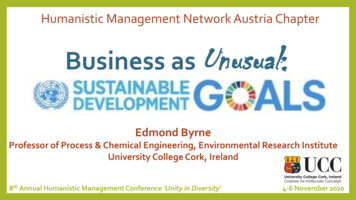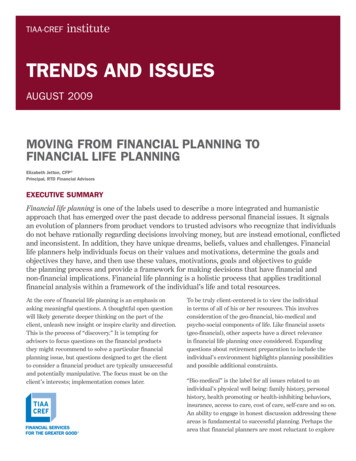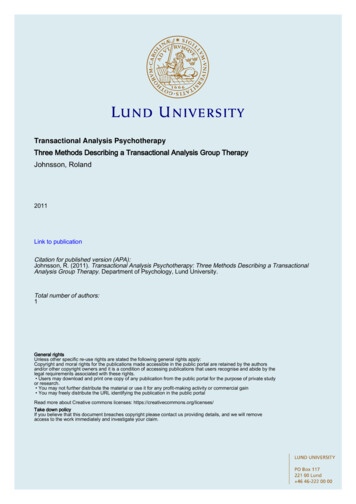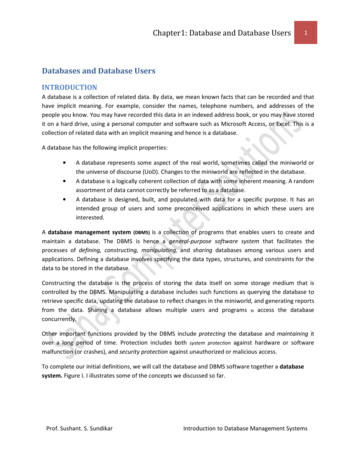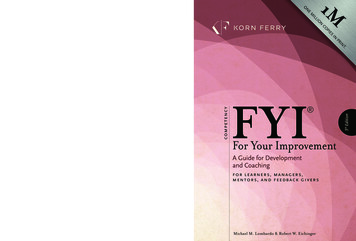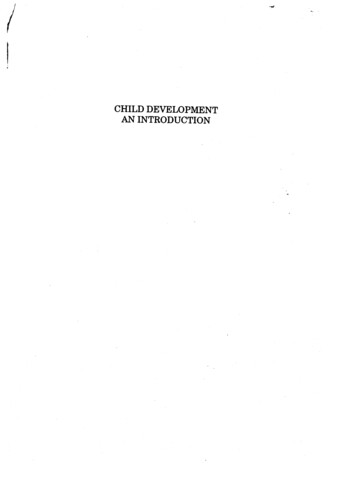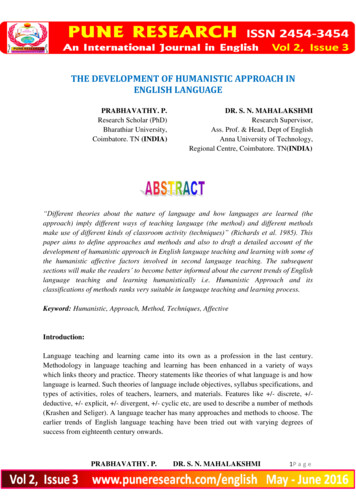
Transcription
THE DEVELOPMENT OF HUMANISTIC APPROACH INENGLISH LANGUAGEPRABHAVATHY. P.Research Scholar (PhD)Bharathiar University,Coimbatore. TN (INDIA)DR. S. N. MAHALAKSHMIResearch Supervisor,Ass. Prof. & Head, Dept of EnglishAnna University of Technology,Regional Centre, Coimbatore. TN(INDIA)“Different theories about the nature of language and how languages are learned (theapproach) imply different ways of teaching language (the method) and different methodsmake use of different kinds of classroom activity (techniques)” (Richards et al. 1985). Thispaper aims to define approaches and methods and also to draft a detailed account of thedevelopment of humanistic approach in English language teaching and learning with some ofthe humanistic affective factors involved in second language teaching. The subsequentsections will make the readers’ to become better informed about the current trends of Englishlanguage teaching and learning humanistically i.e. Humanistic Approach and itsclassifications of methods ranks very suitable in language teaching and learning process.Keyword: Humanistic, Approach, Method, Techniques, AffectiveIntroduction:Language teaching and learning came into its own as a profession in the last century.Methodology in language teaching and learning has been enhanced in a variety of wayswhich links theory and practice. Theory statements like theories of what language is and howlanguage is learned. Such theories of language include objectives, syllabus specifications, andtypes of activities, roles of teachers, learners, and materials. Features like /- discrete, /deductive, /- explicit, /- divergent, /- cyclic etc, are used to describe a number of methods(Krashen and Seliger). A language teacher has many approaches and methods to choose. Theearlier trends of English language teaching have been tried out with varying degrees ofsuccess from eighteenth century onwards.PRABHAVATHY. P.DR. S. N. MAHALAKSHMI1P a g e
Certain earlier methods , namely the Grammar Translation Method which is advocatinglanguage as an exercise in intellectual development through reading and writing of literatureof target language and translating that literature into the learner’s mother language. The‘Grammar-Translation Method’ (18th, 19th and early 20th century) is an early method basedon the assumptions that language is primarily graphic, that the main purpose of secondlanguage study is to build knowledge of the structure of the language either as a tool forliterary research and translation or for the development of the learner's logical powers, andthat the process of second language learning must be deductive, requires effort, and must becarried out with constant reference to the learner's native language.Similarly, the traditional ‘Grammar Translation Method’ if prescribed in terms of features is( deductive, explicit, - discreet and - divergent). Methods of earlier been named using oneor more of these properties which describe the thrust of that method but it is certainly moreeconomical and useful to describe any language teaching method as a combination of severalfeatures rather than just one.The ‘Direct Method’ eschews the learner’s mother tongue and advocates the use of the targetlanguage in developing all the four skills i.e. Listening, Speaking, Reading and Writing.Direct Method, if prescribed in terms of features is the method is ( deductive or - explicit)but it may/may not be a discreet point approach or a cyclic approach. It refers to all thosemethods in which no language other than the target language and no rules of grammar aretaught in explicit‘Structural - Situational Approach’ is a grammatical approach in teaching language through acareful selection, gradation and presentation of vocabulary items and structures, and throughsituation – based activities.A ‘Structural Method’ similarly can be described in terms of features like ( Systematic, Cyclic, discreet, - explicit). It is therefore a more of a description of what is prepared in thename of language teaching materials or texts or say a pedagogical grammar rather than amethod of presenting the same to the learners in a classroom.‘Audio – Lingual/Audio-Visual Method’ is a purely structural approach based on theprinciples of behavioral psychology that views language learning as habit - formation. Theaudiolingual approach, which was very popular from the 1940s through the 1960s, is based instructural linguistics (structuralism) and behaviouristic psychology (Skinner's behaviorism),and places heavy emphasis on spoken rather than written language, and on the grammar ofparticular languages, stressing habit formation as a mode of learning. Rote memorization,role playing and structure drilling are the predominant activities. Audiolingual approaches donot depend so much on the instructor's creative ability and do not require excellentproficiency in the language, being always railed to sets of lessons and books.PRABHAVATHY. P.DR. S. N. MAHALAKSHMI2P a g e
The ‘Bilingual Method’ like Grammar–Translation Method, uses mother tongue equivalentsof the target language utterance to facilitate learning and reading method views reading basicto any language teaching.‘Phonetic Method’ or the ‘Oral Method’ would therefore imply the use of one’s performancechannel i.e. oral medium but then that it is not at all about the method. An oral method mayrecommend practicing linguistic units as discreet units or units in appropriate contextstogether forming an integrated whole. Similarly, an oral method may be cyclic or non cyclic,deductive or inductive, explicit or implicit, etc and so on and so forth.Terms like language teaching ‘methods’ and ‘methodology’ have been in use for a number ofyears now but it is impossible to outline “a single undifferentiated methodologicalprescription” (Stern, Fundamental Concepts 16) that could be applied consistently andcomprehensively to any and every situation in which languages are taught.Chomsky’s Theory:Chomsky’s innatist theory is “Nature” over “Nurture”. The general form of a system ofknowledge is fixed in advance as a disposition of the mind and the function of experience isto cause this general schematic structure to be realized and more fully differentiated(Chomsky 51-52).According to Chomsky, crucial parts of the human language ability are built into the brain –part of our biology, programmed into our genes. Chomsky’s says that the essential core ofgrammar is innate and a generative grammar that can produce an infinite range of novelsentences. By the middle of the twentieth century cognitive psychologists like Vygotsky andPiaget enabled theories which help to explain the limited efficiency of the traditionalprescriptive and also the mechanistic approaches to English language teaching as a secondlanguage.Beginning in the 1950s, Noam Chomsky and his followers challenged previous assumptionsabout language structure and language learning, taking the position that language is creative(not memorized), and rule governed (not based on habit), and that universal phenomena ofthe human mind underlie all language. A language is not just a repertoire of responsesbecause we create brand – new combinations of words every time we utter a sentence; thebrain has the ability to create an unlimited number of sentences out of a finite set of rules(Krishnaswamy and Lalitha). This "Chomskian revolution" initially gave rise to eclecticismin teaching which means a teaching situation in which the teacher doesn’t use any oneparticular method but includes a different mixture of different methods to suit their class.PRABHAVATHY. P.DR. S. N. MAHALAKSHMI3P a g e
Therefore, rather than believe in any single way of teaching, the teacher subscribes tomoderate doses of almost every style of teaching. There are varied methods and approachesto language teaching, each among other things, in an expression of teachers’ beliefs aboutlanguage learning. It is necessary to try and understand the processes of language learningand language teaching and learning, learning and acquisition methodologies etc.,Today, many linguists whether linked with theoretical or applied research aims to categorizeteaching approaches into two main branches such as the humanistic approaches based on thecharismatic teaching of one person, and content-based behavioural approaches, which try toincorporate what has been learned in recent years about the need for active learnerparticipation, about appropriate language input, and about communication as a humanactivity. There has been a great emphasis on individualized instruction called humanisticapproach to English language learning which results in a greater focus on the learner.Humanistic Psychology:A major approach which has achieved increasing influence in education and training circlesis that of humanistic psychology. Arising originally in North American psychotherapy,thisessentially optimistic approach emphasizes the role of feelings and motives relating to selfesteem.In its student- centred application to education it stresses the facilitation of learners' selfdevelopment through respect for their autonomy at all times, the emphasis is on consultationand negotiation.Rogerian’s humanist kind of ‘humanising’ is a word deserves a slightly closer look on careerand it is a good thing for the most frequent associations which are those of impersonal (e.g. acomputer programme), distant or remote (e.g. distance education) or inhumane (e.g. a socialsystem) can be improved through a process of ‘humanising’.The related words 'humanist',‘humanistic’ and ‘humanism’ the verb ‘humanise / humanize’ in an everyday contextwouldn't make any connection with humanists or humanism. But in an educational context,things are rather different. Humanism has had such a profound influence on education in thelast five centuries. The traditions of Renaissance flowered humanism continue to influenceeducational practice in many parts of the world. The American school of educationalhumanism that emerged in the nineteenth century gave a new trend of life and a slightlydifferent meaning to the word.'Humanism' it is the word that again hit international fame in the twentieth century. In theworld of language teaching, humanism of the Rogerians kind made an indelible mark.English language teaching in Britain in 1999, the use of the word humanising in the veryparticular context seems to arouse interest and to be associated with humanist approaches toPRABHAVATHY. P.DR. S. N. MAHALAKSHMI4P a g e
language teaching as they were conceived at the time. The term humanistic describes learningapproaches that assert the central role of the 'whole person' in the learning process.Humanistic approaches emerged in the mid-twentieth century which counterbalance toexclusively intellectual (or cognitive) accounts of learning, such as mentalism. 'Humanising'means 'making better' or 'improving' and whereas 'humanistic' is basically synonymous with'good' aspect (Hilgard). Effective teaching and learning engages the whole person involvingthe mind, the body and the heart. The learner is the central person in the act of learning.Creativity, involvement and enjoyment are the essential elements for lifelong learning. Ahumanist approach to education enhances on the learner as an individual, taking theirinterests and goals as the basis to organize or to mould and facilitate their learningexperiences.On the other hand, learning is not seen as an end in itself, but rather as a means towardsenabling the individual to realize their full potential achieving self‐actualization which refersnot only the academic needs of the learner, but also their emotional, creative, psychological,and developmental needs.The humanistic approach mostly emphasise upon recognizing, valuing the dignity of one’sown self‐worth of every individual learner and upon developing the self‐concept of thelearner so, it starts from the assumption that the learner must feel positive about themselvesand about their ability to improve and progress towards the realization of their full potentialand for this the learner must have a clear and accurate understanding of their own strengthsand weaknesses.In practice, a humanistic method of education emphasis on standards, targets, testing, andstandardized curriculum (Wang). Humanistic theories of learning seems to be highly valuefocussed and hence more like prescriptions (about what ought to happen) rather thandescriptions (of what does happen). It characterises the “natural desire” of everyone to learn.So, the teacher requires a great deal of authority and becomes a facilitator. From 1970s,humanism in education has impressed more and more people’s attention. It is analysed thatperson cannot satisfy his own basic needs both physically and psychologically, so the personfails to put effort on his language learning whole-heartedly.Language learning and the affect which does not mean only the basic needs of human bodyon the whole it means the condition of the physical and psychological activities too. Thushumanistic approach is closely connected and have made many theoretical educators’ toarouse interests in this field to do research in which concept related to humanistic approachstating that the learners’ first to be treated as human being, then as a learner. Languagelearning as a process which involves the whole person which it takes into accounts both thepassion and spiritual needs of an individual too.PRABHAVATHY. P.DR. S. N. MAHALAKSHMI5P a g e
According to Brumfit (1982) the philosophy behind the approach is the ideal world ineducation should consist of ‘autonomous, creative and emotionally secure people’ (Nagaraj56). Stevick’s (1980) classification outlines the most important characteristics of humanismsuch as feelings which include personal, emotional and aesthetic appreciation whereas socialrelations involves the side of humanism which encourages friendship and cooperation and sointellect refers knowledge, reason, and understanding with self actualization which is thequest for full realization of one’s own deepest true qualities.Humanistic Approach and its Affective Factors:The humanistic tradition which represented by Stevick (1980), Curran (1972), Gattegno(1972) Lozanov (1979) and others i.e. Humanism departs from audio- lingual habit theoryand cognitive code learning and emphasizes the learner’s affective domain. Thus, languageshould be learner-centred, and the content, materials and learning activities should take intoaccount the learner’s emotional attitude towards that language, its culture and theirclassmates. Humanism could be summarised saying that it is not really possible to teachanybody anything, only to help learners in their acquisition process. “A language teacher canexpress his theoretical conviction through classroom activities as much as (or indeed, betterthan) through the opinions he voices in discussions at professional meetings” (Stern,Fundamental Concepts 24).History shows different trends or models which show a variety of choices and options thathave been followed (Howatt). Throughout time, the teaching and learning a language processhas been changing and it is interesting to discover the contradictions about the issue so that asolid conclusion is drawn. An open and receptive attitude to analyse the teaching conceptionsupon the best methodology to follow is the key to construct solid foundations.Foreign language learning is a process in which the learner gradually acquires another systemof communication. It is to be realized that the new language is not only a set of codes bywhich the ideas can be expressed, but an important part of a culture different from his own. Infact the learner will find some distinctions in his mother tongue cannot be made in the newlanguage and that other ways of thinking and experiencing are essential to communicate inthe language.As the humanistic approach develops, affect in education gains more and more attention.Some of the factors affect second language learning is anxiety, self esteem, language ego andempathy (Ehrman and Eysenck). Generally, affective factors in language learning are dividedinto two types, first one is individual factors including anxiety, inhibition, extroversion andintroversion, self-esteem and motivation, etc., the second one is rational factors includingcomprising empathy, classroom transaction, cross-cultural processes, and so on. “EgoPRABHAVATHY. P.DR. S. N. MAHALAKSHMI6P a g e
boundaries which are flexible are related to tolerance of ambiguity in .and the ability to takein another language and culture” (Ehrman 76).Anxiety is considered to be the most pervasively obstructive factor in learning process. Itmay be caused by either personal factors like personal hurt, failure, and others’ negativeattitudes especially in the childhood and these unhealed past wounds may influence presentlanguage learning situation. So, anxiety contributes to poor performance in learning process.Self-esteem is a kind of self-judgment of worth or value. Normally, successful languagelearners have higher self-esteem than unsuccessful ones. Language ego refers to the relationbetween people’s feelings of personal identity, individual uniqueness, and value (i.e. theirego) and aspects of their first language. The degree to which one keeps the aspects of one’spersonal experience separate is called ego boundaries which may hinder some aspects ofsecond or foreign language learning.Empathy means putting oneself into someone else’s shoes of reaching beyond the self andunderstanding and feeling what another person understands or feeling with empathy, onedoes not necessarily give up his own way of feeling or totally agree with the position of theother, he is just able to imagine and share the thoughts or feelings. Thus, these are the mostimportant factors affecting second language teaching and learning and also link theharmonious coexistence of individuals in society.The Process of Teaching and Learning:Creation of self-confidence and appropriate environment along with suitable participants andteaching-learning materials and aids are also considered as factors that are highly responsiblefor a better teaching-learning activity. As English is being taught as a language and used as amedium of instruction starting from standard-1. There are a number of factors and aspectswhich have to be given due importance, in order to have a successful educational planningand implementation. Issues related to the teaching and learning process such as rrole,teacherrole,methods/approaches/techniques used and so on are considered as quite prominent andsignificant in the present day context. Hence, the present research study focuses on theaspects of ‘Humanistic Approach’ with reference to teaching and learning English as asecond language at the college level.Teaching and learning process has four aspects such as ‘Teacher’, ‘Student’, ‘Learningprocess’ and ‘Learning situation’ (Aggarwal 54). Though the above four aspects is a commonteaching and learning situation, one can find significant differences as well in different levelsof teaching and learning activity. There is interrelatedness between teaching objectives(ends), learning experiences (means) and evaluation (evidence of what is taught and learnt)PRABHAVATHY. P.DR. S. N. MAHALAKSHMI7P a g e
(58). The teaching and learning process by and large, finds to be depending on the institutionfollowed by the professional teachers. Thus, the teaching and learning process are interlinked.Language teaching is more effective when teachers provide the development of a positiveself-image by sorting success oriented tasks and also in creating a supportive environment.The teachers should allow students’ to take risks and to make errors to experiment with thelanguage in different contexts and registers so that the students become aware of usingappropriate learning strategies.Language learning is facilitated when students’ developed their literacy skills in their firstlanguage and have maximum exposure to the target language. The students should be awareof the learning objectives; the use learning strategies effectively; interact and shareinformation; exchange ideas and opinions and work together by committing errors. Theopportunities to be created to use the target language outside the classroom and motivated tofind out about people, cultures, music and literature related to the target language. The threestages that are important for any language teaching programme is that the first stage is‘evaluating the linguistic grammars’ according to their own terms of reference and extractfeatures which are relevant to language teaching. The second and third stages are ‘preparationof structured syllabus’ and based on the syllabus ‘writing a full array of texts, exercises,explanations’ respectively (Halliday et al. 18).Conclusion:The approach and the four methods of humanistic approach in broad perspective are learnercentered and also share the significance attached to the learners’ feelings and affect foracquisition. In this manner, humanistic approach of English Language Teaching does achieveto motivate learners continuously, to attain confidence level. On the whole if the humanisticapproach and its method are followed in the classroom within a global programme. Manyadvantages would occur introducing by very useful activities, changing the classroom routineand providing the learner with an active role, while at the same time respecting their passionsand reducing their anxiety. The thrust of humanism seems, to be the ability to advance as aspecies through understanding and co-operation. This means that language teachers need tohave a thorough grasp of both how people learn and what motivates them to learn. They needto shed the old image of the teacher being the fount of wisdom and replace it with the teacheras facilitator. Learning is not an end in itself, instead it means to progress towards thepinnacle of self-development. In particular to Engineering course syllabus, TechnicalEnglish- I and II in the present scenario and also states the teaching and learning process withthe importance of study aids for the best implications of Humanistic Approach from a broadperspective.PRABHAVATHY. P.DR. S. N. MAHALAKSHMI8P a g e
1. Aggarwal, J.C. Principles, Methods and Techniques of Teaching. 2nd Revised ed.New Delhi: Vikas Publ. House, 2001. Print.2. Chomsky, N. Aspects of the Theory of Syntax. Mass: The MiT Press: Cambridge,1965. 51- 52.3. Ehrman, M.E. Ego Boundaries and Tolerance of Ambiguity in Second LanguageLearning. In Jane Arnold, ed. Affect in Language Learning. New York:Cambridge University Press, 1999. 68-86.4. Eysenck, M. W. Anxiety, Learning and Memory: A Reconceptualization. Journal ofResearch in Personality: 13 (1979). 363-385.5. Halliday, M. A. K., McIntosh, A. and Stevens, P. The Users and Uses of Language.In J. Webster, ed. Language and Society. London and New York: Continuum,10 (2007).6. Hilgard, E. Motivation in Learning Theory [M]. In S Koch, ed. Psychology: A Studyof Science. New York: McGraw-Hill Book Company, 5 (1963). 253-283.7. Howatt, A. A History of English Language Teaching. Oxford: Oxford UniversityPress, 1984.8. Krishnaswamy, N. and Lalitha Krishnaswamy. Teaching English – Approaches,Methods and Techniques. India: Macmillan, 2003. Print.9. Krashen and Seliger, H.W. “Teachers of English to Speakers of Other Languages.”Inc. (TESOL), TESOL Quarterly, 9:2 (1975).173–183.10. Nagaraj, Geetha. English Language Teaching Approaches, Methods, Techniques. 2nded. New Delhi: Orient Longman, 2008. Print.11. Richards and Rodgers, T.S. Approaches and Methods in Language Teaching. “ADescription and Analysis.” 2 nd ed. Cambridge, UK: Cambridge UniversityPress, 1986.12. Stevick, Earl, W. In Teaching Language: A Way and Ways. Rowley, MA: NewburyHouse, 1980. xiv 304. 2010.13. Stern, H. H. Fundamental Concepts of Language Teaching. Applied Linguistics, 5thed. Oxford: University Press, 1983.16-24.14. Wang, Guilian. Humanistic Approach and Affective Factors in Foreign LanguageTeaching. (University of Shanghai for Science and Technology) Sino – USEnglish Teaching, 2 :5. Serial No.17 (2005). 1-5.PRABHAVATHY. P.DR. S. N. MAHALAKSHMI9P a g e
deductive, /- explicit, /- divergent, /- cyclic etc, are used to describe a number of methods (Krashen and Seliger). A language teacher has many approaches and methods to choose. The earlier trends of English language teaching have been tried out with va
